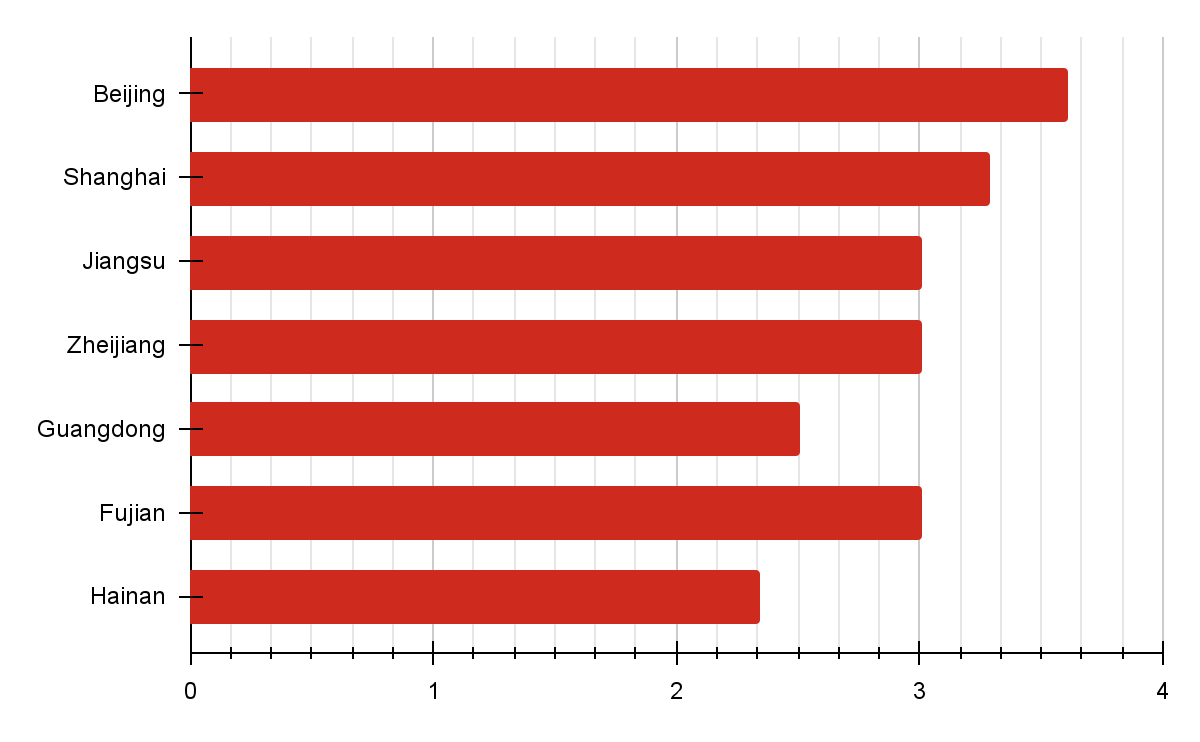Unlike many countries, China does not have a federal minimum wage. Instead, minimum wages are set at the provincial level, leading to significant regional differences.
As of January 2. 2025, Beijing currently has the highest hourly minimum wage in China at CNY 26.4 per hour (approximately USD $3.61). Over a standard 8-hour workday, this equates to CNY 211.2 (around USD $28.88). Other key regions, such as Shanghai, Tianjin, Jiangsu, and Guangdong, base their individual minimum wage structures on local economic conditions and labor policies.
For U.S. businesses hiring in China, navigating regional wage variations, industry-specific labor laws, and foreign employment regulations is essential. Tasks that may be straightforward in domestic hiring can quickly become complex in international settings.
Below, we break down these key distinctions and explore how an Employer of Record (EOR) like Skuad can simplify compliance with Chinese labor laws and ensure seamless workforce management as you expand into the region.
What Is the Minimum Wage?
While many other nations establish a federal minimum wage as a baseline, China – known for its centralized economy – takes a decentralized approach to labor. Each province, municipality, and autonomous region sets a separate minimum wage, resulting in significant regional variations.
Several economic and policy factors influenced these wage differences, including cost of living, local economic development, labor market conditions, and government policies to balance economic growth and worker protections across different regions.
Navigating these regional wage differences is essential for successful business operations in China.
The Ministry of Human Resources and Social Security (MOHRSS) provides guidelines. Still, each province, autonomous region, and municipality determines its own wage policies based on local economic conditions, cost of living, and labor market needs.
These regional minimum wages are established through local government regulations and apply to most workers in their respective jurisdictions. Additionally, industry-specific wage policies may be implemented in certain sectors to address economic priorities and labor demand.
The cure for your headaches: an EOR platform like Skuad. We make tracking, monitoring, and adjusting to shifting labor laws significantly more manageable.Let us do the heavy lifting so you can get back to work.
One platform to grow your global team
Hire and pay talent globally, the hassle-free way with Skuad.
Talk to an expertAnnual Changes
Using an average of regional minimums, wages across China's provinces have steadily increased over the past decade. In 2014, it was CNY 1.86k per hour, rising to CNY 2.69k per hour as of 2024, based on an 8-hour workday.
These adjustments reflect China's efforts to align wages with inflation, support economic growth, address regional labor market demands, and ensure a stable standard of living for workers.
YoY Hourly Minimum Wage Increases in China (USD)

Get the latest updates on miminum wages in China. Talk to our experts.
Minimum Wage in China, Compared
Rising minimum wages make China one of the more competitive global labor markets. It offers access to a skilled workforce, strong labor protections, and economic stability. While wages vary by province, China remains an attractive destination for companies seeking top talent with fair labor costs.
Minimum Wage In China (per day)

*amounts have been converted to USD as a means of standardization across different currencies
Minimum Wage In Chinese Provinces (per day)

How the Law Differs for Foreign Workers in China
Chinese labor laws generally apply to citizens and foreign workers, though some distinctions exist. Foreign employees with valid work permits are entitled to minimum wage protections, workplace safety regulations, and standard employment rights like Chinese citizens.
However, certain benefits, social insurance contributions, and employment restrictions may vary based on local policies and visa classifications.
To help you calculate potential costs, consult our convenient employee cost calculator.
With its profound cultural heritage and long-standing traditions, China integrates public holidays and leave benefits that allow workers to celebrate significant cultural events while ensuring access to standard leave entitlements similar to those in other major economies.
These policies balance honoring tradition and maintaining a productive workforce, providing employees with cultural and personal time off throughout the year.
Vacation Pay in China
Statutory Annual Leave
Employees in China are entitled to paid annual leave based on their cumulative total work experience (not just tenure with a single employer). The leave entitlement is as follows:
- Less than 1 year of experience: No qualified statutory annual leave.
- 1 to 10 years of experience: 5 days per year.
- 10 to 20 years of experience: 10 days per year.
- Over 20 years of experience: 15 days per year.
Employers are expected to calculate annual leave for newly hired employees using the following formula:

Annual leave excludes public holidays, rest days, or other events such as sick or maternity leave.
Unused Annual Leave Competition
If an employee doesn’t use their annual leave and also doesn’t agree to carry it forward, the employer is required to compensate the employee at 300% of their daily wage for each unused day (daily regular salary + an additional 200%)
Employers can calculate daily wages as follows:

Public Holidays in China (2025)
Employees in China are entitled to 13 days of paid public holidays as of January 1, 2025.
They are as follows:
- New Year’s Day - January 1
- Chinese New Year (Spring Festival) - January 28 to February 4
- (Qingming) Tomb-Sweeping Festival - April 4 to April 6
- Labor Day - May 1 to May 5
- Dragon Boat Festival - May 31 to June 2
- Mid-Autumn Festival & National Day - October 1 to October 8
* Dates of these holidays and observances may change based on religious calendars.
Overtime and Public Holidays
Employees required to work on a public holiday must receive 300% of their daily wages for the hours worked.
Additional Leave Policies
China also provides and enforces additional leave policies such as:
- Maternity Leave
- Paternity Leave
- Childcare
- Sick Leave
- Marriage Leave
Managing Compliance
In China, employers must accurately calculate wages, benefits, and leave entitlements while staying compliant with regional labor laws. Managing this internally requires skilled accounting professionals to navigate complex wage structures and statutory contributions.
Partnering with an EOR platform like Skuad offers a seamless solution for businesses looking to hire in China efficiently. We take the headache out of payroll, ensuring timely and compliant payments and reducing administrative burdens, allowing your company to focus on growth while tapping into China’s highly skilled and dedicated workforce.
Skuad handles:
- Payroll processing and wage calculations
- Compliance with federal and provincial labor laws
- Timely payments and tax deductions
Average Income in China
As per the most recent data on Trading economics, the average annual income in China is set to reach around 123,000 CNY (Chinese Yuan) in 2025.
In USD, the China average income would be approximately $17,000.
However, the average monthly income in China differs based on the region, industry and roles.
Now, let’s look at the region-wise breakdown of average income.
Average Income in China- Region-wise Breakdown
Why Use an Employer of Record (EOR)?
Skuad has helped thousands of businesses expand globally without the complexities of setting up a local legal entity. Our platform handles every aspect of employment in China, ensuring compliance, efficiency, and seamless operations so businesses can focus on growth, not red tape.
Want To Hire in China? Work With Skuad
We know that growing your business internationally can be challenging. That’s why we’ve made Skuad as user-friendly as possible. Use the link below to speak with our experts about what we can do for you or request a demo.




















.avif)





.jpg)
.jpg)
.jpg)




